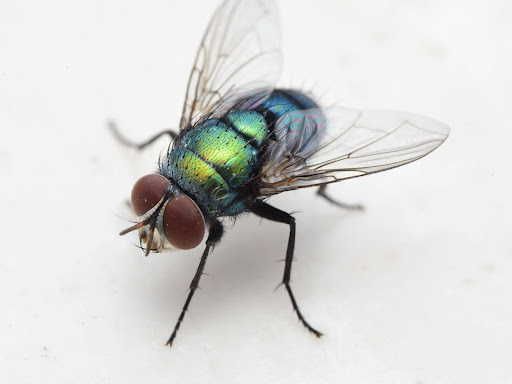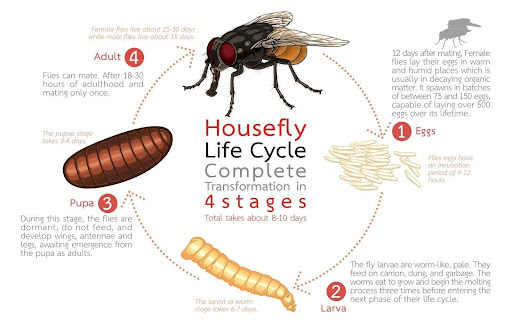
Take a moment to think about what insects you find most annoying. While it may not have been your first thought, most people would agree that flies take the crown. With 120,000 known species, these insects can be found in every terrestrial ecosystem on Earth (yes, including Antarctica). While they play an important role in decomposition and nutrient recycling, they can also spread disease when they feed and reproduce in unsanitary conditions. But, from a pest management perspective, flies can also be frustratingly difficult to eliminate as accurate identification and locating effective areas to provide treatment can be challenging. In the words of one of our service managers, “Flies are weird.”
Let’s review the common structure-infesting flies living here in the Pacific Northwest and discuss ways to prevent them or reduce their activity in and around your home.
Understanding the lifecycle of flies
To manage fly activity, one must understand their lifecycle. Flies undergo complete metamorphosis, meaning they have four distinct life stages: egg, larvae, pupa, and adult.

Females lay eggs (or pre-hatched larvae) on a suitable feeding source, and the larvae feed on it until they enter their pupa stage. These areas where females deposit their eggs are known as “breeding sites.” The pupa stage is like a caterpillar entering their cocoon to become a butterfly. As it morphs into the fly’s adult form, the pupa does not feed or move.
Where do flies come from?
While it may seem like those flies that showed up in the kitchen came out of nowhere, you can be certain that a random influx of flies means that larvae are feeding on something nearby. Identifying the source of a fly infestation can be challenging and may involve various factors:
– House flies will lay eggs in excrement or decaying plant matter.
– Blow flies prefer dead animals, trash, or decaying organic matter.
– Mosquitos lay their eggs in stagnant water or dry lowlands that frequently flood.
– Bot flies ingeniously and horrifically lay eggs on other flies, and when that fly lands on an animal, the larvae will burrow into its skin.
Yikes! We’re not trying to give you nightmares. Instead, we’re giving examples of the diverse survival strategies flies employ and the wide range of potential sources of fly activity.
If that isn’t complicated enough, observing heavy fly activity does not always mean that there is a breeding site close by. Take, for example, a hot sunny day at the height of summer. You suddenly observe dozens of flies in your garage or under the roof of your back patio. Your initial assumption may be an infestation, but flies will move into shaded areas at the day’s highest heat to protect their wings from the damaging heat.
Some flies mimic bees and wasps, but they can be easily differentiated by their wing count: flies have 2 wings (except for some wingless females), while bees and wasps have 4. Flies possess various mouthparts, but those commonly found around homes or kitchens typically have sponging-sucking mouthparts used for drinking liquids. They can also consume solids by excreting an enzyme that helps liquefy and predigest them. As we said, flies are weird.
How To Identify Flies
Finding the source of flies in your kitchen requires some detective work. The first question is whether they are big (house fly-sized) or small (fruit fly-sized). Most people will be able to make this differentiation. (Our website also has a handy pest identification section that can help!)

All about filth flies
Say the flies are roughly the size of a house fly. The 5 most common flies of its size, collectively known as filth flies, found in the home are: house flies, blow flies, bottle flies, flesh flies, or soldier flies. Let’s not worry about telling them apart and instead focus on eliminating the activity, and we can do that by inspecting their primary breeding sites. For any of these flies, common breeding sites include excrement, dead animals, decaying material, or garbage.
Here are some non-chemical treatment ideas to help you get rid of house flies, blow flies, and other filth flies: :
– Clean up pet waste
– Empty and clean trash cans with soap and water
– Deep clean the kitchen, including behind the refrigerator and oven
– Remove sources of moisture

If you’ve followed these steps and still notice fly activity, it might indicate the presence of a dead animal, such as a rodent, in your attic, crawlspace, or wall void. While you can attempt to locate and remove the carcass, there’s no guarantee of success. However, as the carcass dries out, the fly issue will likely resolve on its own. The most effective approach is to prevent rodents from entering your home altogether. At Interstate Pest Management, we offer rodent services designed to help you achieve this goal. Learn more about rodent control and removal services near you.
All about small flies
Now imagine that the flies in your kitchen are small, more like the size of a fruit fly. This could be fruit flies (or vinegar flies as some call them), phorid flies, moth flies, fungus gnats, small dung flies, or cheese skippers. Common breeding sites for these flies include rotting fruits and vegetables, drains, and garbage.
Want to know how to get rid of fruit flies? Try these suggestions:
– Inspect produce for signs of decay and discard as needed
– Empty and clean garbage cans with soap and water
– Clear drains and garbage disposal of food buildup and biofilm
– Remove sources of moisture
Products can be purchased over the counter to target fly activity in drains or try DIY solutions like using salt, baking soda, and vinegar in the drain overnight.
If you’ve followed these steps and still notice small flies, check meats and cheeses for signs of cheese skipper breeding. Additionally, examine potted plants, as over-watering can lead to fungi proliferation in the soil, attracting fungus gnats. Allow the soil to dry out and reduce watering frequency. Products available at garden or hardware stores can be dissolved in water and applied to plants to prevent fungus gnat infestations.
How do you keep flies away?
Pest management professionals can assist with finding sources of activity and help manage adult fly activity. Ultimately, the only way to eliminate persistent infestations is to find the sources the larvae are feeding on and remove them.
When infestations are persistent or conducive conditions cannot be entirely mitigated, there are a plethora of options available for reducing adult fly activity. Sticky traps, fans, baits, and light traps can be effective defense and deterrence.
Fruit fly traps can be purchased to help reduce activity, but they can also be easily made by adding sugared water to a bowl, covering it with plastic wrap, and punching a few holes in the wrap with a toothpick.
Restaurants, coffee shops, and grocery stores should consider insect light traps (ILTs). Though the upfront costs may seem high if maintained well, they can last for years, and we at Interstate Pest Management can help you set up and maintain your own. Learn more about our commercial pest control services. Even if you do not think you are having an issue with flies, you will be surprised at how many captures you will see over a few weeks with an ILT, and catching adults early can help reduce the likelihood of an infestation.

Consider switching to bulbs or filters that emit wavelengths of light that do not attract insects to the exterior of your home or business.
How to find a fly exterminator near you
If you are having trouble figuring out where to begin, looking for advice, or help with treatments, call us at Interstate Pest Management. We are a local pest control company familiar with the common types of fly infestations here in the Pacific Northwest. One of our licensed technicians will come by to evaluate your unique situation and figure out the next steps to prevent, manage, and eliminate your fly problem.
Flies control and removal are also included in two of our year-round All-Seasons Pest Service packages. If you live in or around Portland, Vancouver, Kelso, or Olympia, contact us today to get started, or even if you just have a question!
Remember, Portland may be weird, but flies are weirder.